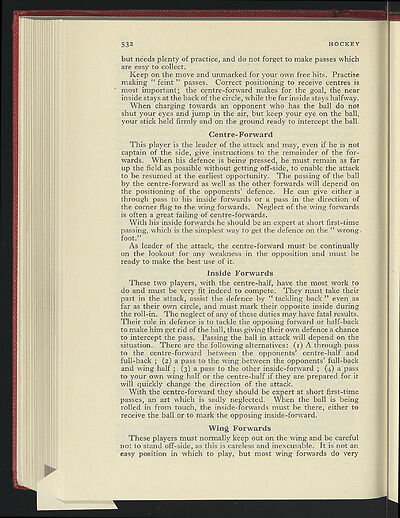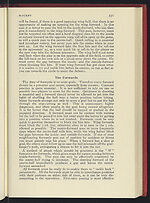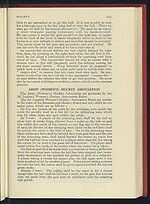1957-58
(552)
Download files
Complete book:
Individual page:
Thumbnail gallery: Grid view | List view

532
HOCKEY
but needs plenty of practice, and do not forget to make passes which
are easy to collect.
Keep on the move and unmarked for your own free hits. Practise
making " feint " passes. Correct positioning to receive centres is
most important; the centre-forward makes for the goal, the near
inside stays at the back of the circle, while the far inside stays halfway.
When charging towards an opponent who has the ball do not
shut your eyes and jump in the air, but keep your eye on the ball,
your stick held firmly and on the ground ready to intercept the ball.
Centre
-
Forward
This player is the leader of the attack and may, even if he is not
captain of the side, give. instructions to the remainder of the for-
wards. When his defence is beini pressed, he must remain as far
up the field as possible without getting off-side, to enable the attack
to be resumed at the earliest opportunity. The passing of the ball
by the centre-forward as well as the other forwards will depend on
the positioning of the opponents' defence. He can give either a
through pass to his inside forwards or a pass in the direction of
the corner flag to the wing forwards. Neglect of the wing forwards
is often a great failing of centre-forwards.
With his inside forwards he should be an expert at short first-time
passing, which is the simplest way to get the defence on the " wrong.
foot." As leader of the attack, the centre-forward must be continually
on the lookout for any weakness in the opposition and must be
ready to make the best use of it.
Inside Forwards
These two players, with the centre-half, have the most work to
do and must be very fit indeed to compete. They must take their
part in the attack, assist the defence by " tackling back " even as
far as their own circle, and must mark their opposite inside during
the roll-in. The neglect of any of these duties may have fatal results.
Their role in defence is to tackle the opposing forward or half-back
to make him get rid of the ball, thus giving their own defence a chance
to intercept the pass. Passing the ball in attack will depend on the
situation. There are the following alternatives: (i) A through pass
to the centre-forward between the opponents' centre-half and
full-back ; (
2)
a pass to the wing between the opponents' full-back
and wing half ; (3) a pass to the other inside-forward ; (4) a pass
to your own wing half or the centre-half if they are prepared for it
will quickly change the direction of the attack.
With the centre-forward they should be expert at short first-time
passes, an art which is sadly neglected. When the ball is being
rolled in from touch, the inside-forwards must be there, either to
receive the ball or to mark the opposing inside-forward.
Wing Forwards
These players must normally keep out on the wing and be careful
not to stand off-side, as this is careless and inexcusable. It is not an
easy position in which to play, but most wing forwards do very
HOCKEY
but needs plenty of practice, and do not forget to make passes which
are easy to collect.
Keep on the move and unmarked for your own free hits. Practise
making " feint " passes. Correct positioning to receive centres is
most important; the centre-forward makes for the goal, the near
inside stays at the back of the circle, while the far inside stays halfway.
When charging towards an opponent who has the ball do not
shut your eyes and jump in the air, but keep your eye on the ball,
your stick held firmly and on the ground ready to intercept the ball.
Centre
-
Forward
This player is the leader of the attack and may, even if he is not
captain of the side, give. instructions to the remainder of the for-
wards. When his defence is beini pressed, he must remain as far
up the field as possible without getting off-side, to enable the attack
to be resumed at the earliest opportunity. The passing of the ball
by the centre-forward as well as the other forwards will depend on
the positioning of the opponents' defence. He can give either a
through pass to his inside forwards or a pass in the direction of
the corner flag to the wing forwards. Neglect of the wing forwards
is often a great failing of centre-forwards.
With his inside forwards he should be an expert at short first-time
passing, which is the simplest way to get the defence on the " wrong.
foot." As leader of the attack, the centre-forward must be continually
on the lookout for any weakness in the opposition and must be
ready to make the best use of it.
Inside Forwards
These two players, with the centre-half, have the most work to
do and must be very fit indeed to compete. They must take their
part in the attack, assist the defence by " tackling back " even as
far as their own circle, and must mark their opposite inside during
the roll-in. The neglect of any of these duties may have fatal results.
Their role in defence is to tackle the opposing forward or half-back
to make him get rid of the ball, thus giving their own defence a chance
to intercept the pass. Passing the ball in attack will depend on the
situation. There are the following alternatives: (i) A through pass
to the centre-forward between the opponents' centre-half and
full-back ; (
2)
a pass to the wing between the opponents' full-back
and wing half ; (3) a pass to the other inside-forward ; (4) a pass
to your own wing half or the centre-half if they are prepared for it
will quickly change the direction of the attack.
With the centre-forward they should be expert at short first-time
passes, an art which is sadly neglected. When the ball is being
rolled in from touch, the inside-forwards must be there, either to
receive the ball or to mark the opposing inside-forward.
Wing Forwards
These players must normally keep out on the wing and be careful
not to stand off-side, as this is careless and inexcusable. It is not an
easy position in which to play, but most wing forwards do very
Set display mode to:
![]() Universal Viewer |
Universal Viewer | ![]() Mirador |
Large image | Transcription
Mirador |
Large image | Transcription
| Games and sports in the army > 1957-58 > (552) |
|---|
| Permanent URL | https://digital.nls.uk/248858176 |
|---|
| Description | 'Games and Sports in the Army' was an annual publication produced by the British War Office between the 1930s and 1960s. This included the Second World War. It outlines the rules and regulations for games and sports played by members of the armed forces. It features names and photographs of team members, and examples of contemporary advertising. |
|---|---|
| Shelfmark | GWB.52 |

